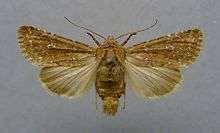Conisania leineri
Conisania leineri is a species of moth of the family Noctuidae. It is found in Central Europe, along the Baltic Sea coast, eastward to the southern Ural.
| Conisania leineri | |
|---|---|
 | |
| Scientific classification | |
| Kingdom: | |
| Phylum: | |
| Class: | |
| Order: | |
| Family: | |
| Genus: | |
| Species: | C. leineri |
| Binomial name | |
| Conisania leineri | |
| Synonyms | |
| |
The wingspan is 29–36 mm. Adults are on wing from May to July in one generation per year. Adults feed on the flower nectar of Syringa species.
The young larvae feed on roots and stems of various Artemisia species, including Artemisia campestris. Larvae are found in July and August. They overwinter as a pupa.
Subspecies
- Conisania leineri leineri
- Conisania leineri furcata (Eversmann, 1837)
- Conisania leineri pomerana (Schulz, 1869)
gollark: Hello! As you may know, I am (barely) staff in old esolangs. For transparency purposes I also share some of the staff discussion which goes on there. They recently complained about this; palaiologos apparently wants me to post *full* context for staff discussions instead of my somewhat small screenshots, including retroactively in the case of the rules change discussion since apparently people have been led to believe that the staff weren't mostly in favour of this. Thusly, here you go.
gollark: And also the permissions system, via [REDACTED] beeonic incursions.
gollark: Well, you are in our hearts.
gollark: Baidicoot is a staff however.
gollark: It would have been nice if the original server was okay, but palaiologistry palaiologizes with increasing metapaliologistics.
References
External links
| Wikimedia Commons has media related to Conisania leineri. |
| Wikispecies has information related to Conisania leineri |
This article is issued from Wikipedia. The text is licensed under Creative Commons - Attribution - Sharealike. Additional terms may apply for the media files.